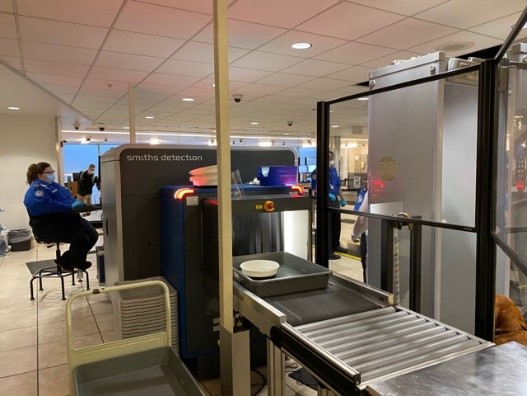
SPOKANE, Washington - With an anticipated spike in the number of people traveling around the spring break period, the Transportation Security Administration (TSA) highlighted its use of new technologies and modified security procedures to help protect the health and safety of travelers departing Spokane International Airport (GEG).
TSA is using computed tomography (CT) technology in the security checkpoint at GEG to screen travelers’ carry-on luggage. The CT scanner applies a sophisticated algorithm during the screening process while an X-ray camera shoots hundreds of images while spinning around the conveyor belt, generating a 3-D image of the item being screened.
The image can be manipulated on screen to allow for a better view of the bag’s contents, allowing a TSA officer to clear the contents of a bag for security threats without having to manually open it for a bag check. Fewer bag checks is beneficial since it reduces physical contact between the traveler and a TSA officer and speeds up the overall screening process. In addition, travelers can leave everything in their carry-on bag, including electronics and food, when it is screened through a CT scanner.
TSA is also using Credential Authentication Technology (CAT) at GEG. These units are able to confirm the validity of a traveler’s photo identification and confirm flight information in near real time. When travelers approach the travel document checking podium when CAT is in use, they may be prompted to insert or scan their own photo identification. This self-service opportunity eliminates the need to hand over photo ID and boarding pass to the TSA officer, reducing potential cross-contamination. CAT units are also able to identify fraudulent documents and those that have been tampered with.
Earlier this year, TSA completed installation acrylic barriers in all of the airport’s security checkpoints. The protective barriers are located in areas where TSA officers typically interact most closely with travelers. These clear shields instill an additional layer of confidence among travelers and TSA employees during the screening process.
Over the past several months, TSA has modified its procedures as part of its “Stay Healthy. Stay Secure.” campaign. Travelers departing GEG and airports across the country can expect to see:
- All security officers wearing face masks and gloves during the screening process. If a security officer is working in close proximity to travelers, they are also required to wear eye protection or a face shield. Security officers will change their gloves after each screening position rotation, after a pat-down or upon a passenger’s request.
- All travelers wearing a mask in the airport and at TSA airport screening checkpoints. Face coverings need to cover the nose and mouth and fit snugly against the sides of the face without gaps. A TSA officer will ask travelers to briefly adjust their mask for ID verification purposes. Travelers without a mask may be denied entry, boarding, or continued transport. Failure to comply with the mask requirement can result in civil penalties.
- Social distancing leading up to and in the security checkpoint environment.
- Increased frequency and intensity of cleaning and disinfecting surfaces in the security checkpoint including bins. This is no substitute for practicing good hygiene while traveling. Travelers are encouraged to wash their hands before and after going through the checkpoint.
Here are some additional tips for traveling during the spring break period:
Step 1: Pack smart
Travelers should be aware of the contents of their carry-on bags and make sure they are not bringing prohibited items to the security checkpoint. To determine whether an item is allowed or prohibited in carry-on luggage, download the MyTSA app and use the “Can I Bring?” feature. By planning ahead, travelers can avoid a bag check and reduce the potential for cross-contamination.
Step 2: Secure items in your carry-on
When removing items from pockets such as phones, keys or loose change, travelers should secure them in their carry-on bags instead of placing them in bins. Bins are a common use item and travelers should use caution or avoid placing personal items in them.
Step 3: Traveling with hand sanitizer
TSA is allowing one liquid hand sanitizer container, up to 12 ounces per passenger, in carry-on bags. Passengers may also bring hand wipes of any size or quantity through security checkpoints.

